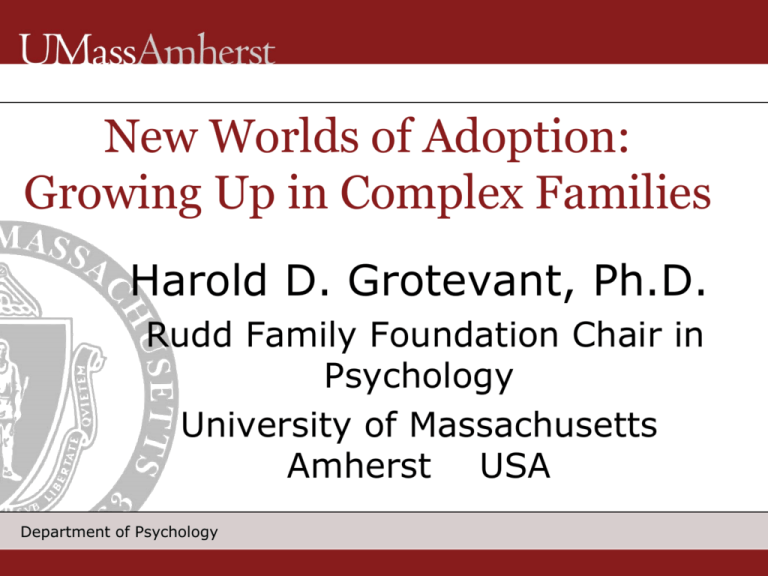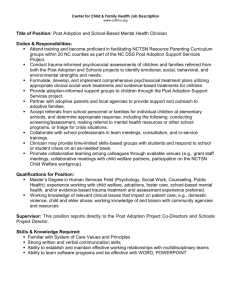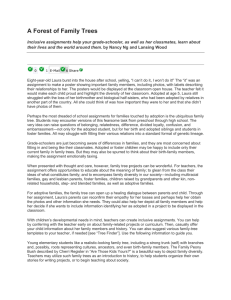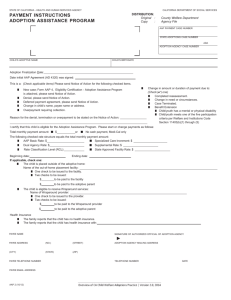Grotevant_SRHD2010 - HomePage Server for UT Psychology
advertisement

New Worlds of Adoption: Growing Up in Complex Families Harold D. Grotevant, Ph.D. Rudd Family Foundation Chair in Psychology University of Massachusetts Amherst USA Department of Psychology Thanks to SRHD for the Invitation! Adoption Touches Many Lives More than 5 million adopted persons in U.S. 1.5 million children currently live in adoptive families Over 1.6 million women have taken concrete steps toward adoption at some point As many as 60% of Americans have a direct personal to adoption Evan B. Donaldson Adoption Inst, U.S. Census 2000 Adoption as a Diverse Family Form Varies by adopting parent(s) • single or two-parent • same-sex or straight • same or different race from child • same or different nationality from child • both parents unrelated to child vs. one related (stepparent) Varies by characteristics of the adopted child placed as infant or at older age placed in good health or with special needs adopted alone or with siblings Varies by intermediary private adoption agency public child welfare system independent adoption Varies by circumstances leading to adoption birth parents wanted a better life for the child than they could provide not emotionally ready to parent unwilling to parent following rape or incest child removed by courts (abuse, neglect, chemical dependency) 4 Distinct Worlds of Adoption in U.S. Adoption of children from child welfare system (~51,000 / yr) International adoptions (~17,200 / yr) Infant adoptions – children voluntarily placed by birthparents (~14,000 / yr) Kinship adoptions, incl. by stepparents (~53,000 / yr) [data from U.S. DHHS / CWIG ; Dept of Homeland Security - orphan visas] Each "world" differs in terms of Characteristics of adopters motivations, demographics The children - physical & mental health, histories, risks Population dynamics & trends Family & community challenges Laws and policies that pertain Expanding Conceptualizations of Adoption Currently in USA... Adoption is a legal process: Parenting rights and responsibilities are legally transferred from birth to adoptive parent(s). Child is “subtracted” from one nuclear family and “added” to another. Toward a New Conceptualization... Instead, adoption creates a new “adoptive kinship network” that permanently links the families of birth and of rearing together, through the child, who is shared by both. Movement toward Openness in Adoption Started in private adoption agency placements in late 1970s - early 1980s Contributing dynamics: • Fewer babies to place, yet high demand • Evolving view that contact may be in the best interests of the child Typical features of open adoption in domestic infant placements Birth parent(s) chooses the adoptive family Direct contact between birth family and adoptive family members Nevertheless, adoptive parents are the legal parents and have all legal parenting rights and responsibilities. Contact may include meetings, phone calls, exchange of pictures, gifts, letters, e-mails, Skype, etc. Contact may involve different people Frequency varies widely Agreements may be verbal or written What Have We Learned?? Collaborative Team Hal Grotevant, UMass Amherst Ruth McRoy, U of TX, Boston College Gretchen Wrobel, Bethel Univ Martha Rueter, Univ of Minnesota Susan Ayers-Lopez, U of TX Lynn Von Korff, U of Minn Many talented graduate and undergrad students and volunteers Sincere Thanks to our Funding Partners National Institute of Child Health and Human Development National Science Foundation William T. Grant Foundation Rudd Family Foundation Chair Overarching Research Questions Are there links between openness (structure and process) and psychosocial outcomes for adopted persons, adoptive parents, & birth parents? How are relationships managed within adoptive kinship networks? (e.g., emotional distance regulation) Participants: Wave 1 (1987-92) 190 adoptive families: parents mostly white, middle to upper middle class; mean age 40 yrs; adopted because of infertility children: ages 4 – 12 (M=7.8 yrs); infant placements; no transracial, international, or special needs placements 169 birthmothers: mostly white, ages 14-36 at placement (M=19.3 yrs); voluntary placements – wanted a better future for her child Participants: Wave 2 (1996-2000) approx 8 years after Wave 1 At least one member in 177 of 190 original families – seen in their homes across the U.S. 173 adoptive mothers & 163 adoptive fathers 156 adolescents (M=15.6 yrs) 127 birthmothers Participants: Wave 3 (2005-2008) approx 9 years after Wave 2 169 young adult adoptees (ages 21-30; M=25.0 yrs) 103 close relationship partners 151 adoptive mothers 134 adoptive fathers Methodological Approach Multiple respondents • adopted child, both adoptive parents, agency staff, birth mother (W1&2), relationship partner (W3) Multiple types of measures • extensive personal interviews, standardized questionnaires, family interaction task (W2), school records (elem school into college) Quantitative and qualitative Use of technology • web-administered measures & online interactive interview (chat) at W3 for young adults Child / Adolescent / Young Adult Outcomes Adoption Adjustment --adoptive identity, curiosity, information seeking Family Dynamics in Kinship Network --emotional distance regulation Mental health --internalizing, externalizing, adaptive functioning, school performance Close relationships outside the family --relationships with peers, intimacy Identity involves integration of different elements Things that are chosen: career path values religious & political commitments views of self-in-relationships And things that do not involve choice – but must be integrated: gender race / ethnicity sexual orientation being adopted Adoption Adds Complexity to Identity Development – there may be... lack of information about history, family, and culture need to integrate difficult information need to understand self where people don’t look like you BUT adoptive identity is not just the sum of "facts" Adoptive Identity - Measurement Narrative approach has guided our interest in both process and structure of identity. Key variables are coded from lengthy interviews about adoption with adolescents and emerging adults. Latent Profile Analysis revealed unitary adoptive identity construct composed of • Adoptive Identity Exploration • Internal Consistency • Flexibility Linking Parental Facilitation of Birth Family Contact With Adoptive Identity Development (Von Korff, 2008) Are there age and gender differences? How stable is adoptive identity from adolescence to emerging adulthood? Is parental facilitation of contact with birth relatives associated with adoptive identity during adolescence? Does this effect continue into emerging adulthood? Are there age and gender differences? AT ADOLESCENCE (ages 12 - 20, M = 15.6 yrs) • age: β = .31, t=4.67 • gender: β = .21 (females), t = 2.71 AT EMERGING ADULTHOOD (ages 21-30, M=25.0 yrs) • age: β = .02, ns • gender: β = .09, ns How stable is adoptive identity from adolescence to emerging adulthood? • β = .53, t=7.05 Is parental facilitation of contact with birth relatives associated with adoptive identity during adolescence, controlling for age & gender? • β = .29, t=3.89 • R2 = .21 Does this effect continue into emerging adulthood? • indirect effect through adolescent identity: β = .15, t=2.99 • R2 = .28 “I think that I am who I am not just because of my family who raised me, or because of the two people that made me. I think it’s a combination of all that. Being able to know all of them has really helped me to become who I am.” (female, age 18) “As soon as I met my birthfather, I knew who I was. I don’t know why that had anything to do with it, but I was more focused on me. I didn’t actually feel a part of the [adoptive] family until I met my biological parents….I could become “me” after meeting someone else.” Older Literature on "Searching" Argued that adoptees searched for birth relatives because they had poor relationships with their adoptive parents or because they were emotionally troubled But many of these studies are from clinic populations or from groups of adoptees organized to help each other search. New Distinctions Emerged from MTARP Curiosity Information-seeking Searching Wrobel, Grotevant, & McRoy (2004) Wrobel, Grotevant, Von Korff, McRoy, Ayers-Lopez (2004) Wrobel, Von Korff, Grotevant (2006) Wrobel, Grotevant, Von Korff (2008) Skinner-Drawz, Wrobel, Grotevant, Von Korff (in press) Wrobel & Dillon (2009) Wrobel, Grotevant, Von Korff (2009) Adoption Curiosity Pathway Model (Wrobel & Dillon, 2009) Curiosity Info Seeking Barriers Searching? Facilitators Curiosity What are adolescents most curious about? 1. Why was I placed for adoption? 2. Are my birth parents raising other children - do I have brothers or sisters I don't know about? 3. What do my birth parents look like? 4. How are they doing? What Have We Found? Information seeking is NOT related to: adolescents' attachment to their adoptive parents adolescent adjustment Information seeking IS related to: positive expectations of relationship with birth parents higher levels of adoptive mothers' communicative openness about adoption lower levels of independence-granting by adoptive mothers (i.e., more maternal control) lower levels of perceived barriers higher levels of perceived facilitators Note: some of the barriers and facilitators are policies about access to information. Evidence-based guidance for professional practice and for families: Curiosity is normal part of development Information seeking is about identity and not necessarily about developing a relationship with birth relatives Parental control stimulates information seeking Barriers & facilitators influence information seeking Family Dynamics in Adoptive Kinship Networks Fear of Reclaiming Emotional Distance Regulation Management of Relationships What Does it Take to Make Contact Work? Special Considerations in Adoptions from Child Welfare System and International Adoptions Comfort Zone of Interaction Individuals have "range of tolerance for separation and connection - a comfort zone" (Farley) When forming the adoptive kinship network, differences must be contended with in a dynamic process involving connection and separation over time Adoption often pulls adults out of their comfort zones Ideal situation - mutually agreeable fit Reality - like all families --Grotevant (2009) “We used to write daily and call each other weekly, I mean in the beginning. When the children were real little, it was tremendous intensity. And I think as our birthmother became more secure in herself and went on to finish college, her need to have to see them once a week or once a month became less and less. And you know, she feels more comfortable with us, we feel more comfortable with her, and we just know that we always have access... You just take it one day at a time. If you want it to work, you’ll work at it. We feel it’s healthy and want it to work because of our children.” (adoptive mother) Emotional Distance Regulation Begins Prior to Placement Participants bring • Developmental histories • Expectations about relationships & adoption • Relationship skills "Typical" Changes over the Life Course of the AKN Contrasting desires for contact by APs and BPs at the beginning, and diverging changes over time Increasing role of the child in contact decisions Birthmother’s "watchful anticipation" of 18th birthday … but "teenage things take over" Non-normative Changes Require Continued Distance Regulation: "Life Happens" Entrances and exits of AKN members • Adoption and birth of additional children • Adoptive parent divorces and deaths • Birthmother marriages and births Geographical moves Mis-steps in the Dance Provide Opportunities for Growth Paradoxical relationship Boundary violations Inappropriate familiarity What does it take to make contact work? Shift in thinking from nuclear family to adoptive kinship network Valuing of child’s dual connection to birth and adoptive parents Flexibility in day-to-day logistics Excellent communication skills Commitment to the relationship – in the best interest of the child Contact Involves Special Challenges When the Child Had Been Removed from the Family Questions about regulating the contact: who? when? where? Protecting the child against recurrence of trauma Developing empathic understanding of birth parents’ situation Consideration of extended family and sibling contact Contact Issues in International Adoptions • Cultural issues (stigma, shame) • Cultural understandings about permanence • Language barriers • Economic disparities Conclusions Adoption is changing to meet the needs of children and families. Because the concept of family is culturally and historically bound, adoption will continue to change and adapt. However, we know much about the developmental needs of children – and we need to make sure that new forms of adoption meet those fundamental needs. It’s All About the Kids ... Thank you for your interest! Contact: Harold Grotevant hgroteva@psych.umass.edu Department of Psychology




